 Zvi Paltiel, The Network of Youth Excellence
Zvi Paltiel, The Network of Youth Excellence
paltiel.zvi@gmail.com
Informal, or extracuricular, science education offers activities aiming at inspiring the participants and eventually engaging them further in either informal or curricular science learning. After-school science clubs, science camps, workshops and many other activities are often considered in this context. Wide in terms of its content
Yet another important aspect of the content is the competitive element. Many students may prefer activities having no competitive element at all, such as science clubs or popular science lectures. Others are attracted by the opportunity to challenge their peers. They prefer contests such as Olympiads and tournaments. Some programs may include competitive elements though they are not as competitive as indi-vidual contests. Team competitions and tournaments allow sharing the risks and the excitement with team members, thus alleviating some of the competitiveness. Other programs, such as symposia at which the best presenter is selected, are not as competitive as the benefits of attending the symposium might well exceed the best presenter competition. Where
Traveling activities such as those carried out by Science Mobile teams, lecturers or demonstrators can also be carried out at schools, community centers or similar places at towns far away from the Science Center in charge. When Who
The vast majority of the average students will become the majority of citizens of the future society. They will have to decide and eventually vote on issues which require a certain level of scientific knowledge and acquaintance with scientific thin-king. Contemporary debates about what, if anything, we should do with regard to global warming, mobile phone radiation hazards, risks of using new materials and genetically modified food, underline the basic understanding of science everyone should have presently.
Needless to say that we also should aim at all other sectors of society, minorities included. In many cases special attention should also be paid to the participation of both genders – girls and boys. Occas-ionally, the program should take differences into account. For instance, we found that girls are not as eager to compete individually. Not a single girl took part in our computer science Codeguru individual competition. Hence we arranged another computer science contest, Codeguru Extreme; this team tournament succeeded in drawing female participants. Many girls are also taking part in teams in our Physics and Chemistry Tournaments (Fig. 4).
Mixed participation of the two genders, various age groups, and various nationalities often enhance the activity, provided proper planning and execution are carried out. There are however, occasions where separate activities for each participant group are more appropriate due to differences in their scientific backgrounds or comprehension, or due to social and cultural constraints. Summary To better comply with its mission, informal science educational organizations should make the effort to offer a wide range of activities – wide in every aspect and dimension. Activities at various levels, diverse scientific fields, and range of competitive nature, should be offered at a variety of theoretical and hands-on combinations. |
[sci-literacy]
neformalno naučno obrazovanje - široko u svim pravcima
Cvi Paltiel
(preveo Vigor Majić)
Ugledni izraelski pedagog, inače fizičar po struci, Cvi Paltije, dugi niz godina radio je u rganizaciji prestižnog Međunarodnog naučnog instituta, odnosno jednog od najelitnijih letnjih naučnih kampova za mlade u okviru Vajcmanovog instituta.
U ovom članku on govori o neformalnom naučnom obrazovanju, odnosno obrazovanju koje se stiče van školskih institucija, kao o obrazovanju koje ponajviše inspiriše mlade. Za razliku od formalnog obrazovanja smeštenog u okvire nastavnih programa i standardnih zahteva za ovladavanjem znanja, neformalno obrazovanje je usmereno na buđenje radoznalosti. Učešće učenika u raznim oblicima neformalnog obrazovanja, kao što su školske sekcije ili letnji kampovi, nije obavezno i zato nije opterećenje za đake.
Da bi bilo privlačno za mlade, neformalno obrazovanje je razvilo širok spektar oblika, sadržaja i načina izvođenja, što učenicima omogućuje izbor. U ovom tekstu on je ilustrovao višedimenzionalnost neformalnog obrazovanja razmatrajući njegove moguće oblike i načine izvođenja.
Na prvom mestu, to je predmet, odnosno sadržaj. Tako danas u školama možemo naći sekcije iz svih vrsta predmeta, dok je u naučnim kampovima tematska raznovrsnost još i veća. Ne samo oblast ili tema, već i dubina, odnosno nivo rada, takođe nude široke mogućnosti izbora zavisno od uzrasta, predznanja ili stila. Tako, neko može preferirati teorijska predavanja, dok drugima više odgovaraju kompjuterske igre ili praktičan rad u laboratorijama. Dalje, nekim učenicima više odgovaraju aktivnosti sa takmičarskim elementima, dok drugima ne. Takmičarske aktivnosti se protežu od smotri i izdvajanja najboljih radova, sve do olimpijada nacionalnog ili međunarodnog nivoa.
Mesto gde se neformalno obrazovanje vrši je veoma važno. Obično tzv. ‘centri’ nude programe za učenike koji ne žive daleko, dok su kampovi prvenstveno okrenuti višednevnim aktivnostima za mlade iz udaljenih mesta. Kampovi moraju obezbediti smeštaj i ishranu. Ponekad, čak i jednodnevni događaji kao festivali nauke, jednodnevni simpozijumi ili vrlo atraktivna predavanja mogu privući učesnike iz daleka. S druge strane, poznata su i iskustva putujućih muzeja, mobilnih naučnih škola koje se mogu locirati u malim sredinama. Danas je moguće razvijati i virtuelne programe omogućujući mladima kod kuće prisustvo na daljinu u zanimljivo dizajniranim programima.
Vreme izvođenja aktivnosti takođe može biti različito. Školske sekcije ili klubovi obično imaju neki fiksni dan okupljanja ali su teško dostupni onima koji žive daleko. Njima su pogodnije povremene aktivnosti kao što su radionice ili naučni kampovi, obično smešteni neradnim danima ili tokom raspusta. Neke aktivnosti se najvećim delom obavljaju u školi ili kod kuće ali zahtevaju barem jednom direktno prisustvo; to je slučaj sa učeničkim sajmovima nauke, turnirima ili izradom samostalnih projekata. Uglavnom sve se ove aktivnosti odvijaju po danu, u radno vreme škole ili neposredno nakon časova. Takođe su moguće i noćne aktivnosti gde su dobar primer astronomski klubovi.
Važno pitanje je ko u svemu tome može da učestvuje. U principu, važno je imati programe za sve – od programa za talentovanu decu, do programa za one kojima nauka nikako “ne ide”. Jako je važno pokriti što veći deo populacije, jer tako formiramo kulturni profil budućeg društva. Mi smo u Izraelu imali problem sa prisustvom devojčica u kompjuterskim programima ali smo to rešili formiranjem novog programa sa drugim pravilima koji je uspeo da privuče devojčice. Ne smemo zaboraviti ni rad sa odraslima. Sjajni su programi u kojima zajedno učestvuju roditelji i njihova deca. Kada govorimo za koga su programi, dodajmo i problem maternjeg jezika. Kada imamo učesnike koji govore istim ili sličnim jezikom, normalno je da se program odvija na tom jeziku. No, kod međunarodnih kampova je logično izabrati neki od rasprostranjenih svetskih jezika.
U zaključku autor sugeriše da uspešna misija promocije nauke zahteva od organizatora da razvija široku paletu aktivnosti koja pokriva što je moguće veći deo populacije.
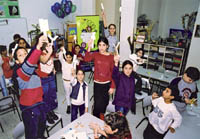 Fig. 1: Proud participants of a two hour workshop show their hand-made cardboard models. Often a tangible take-home product is useful in inspiring and engaging young participants. The activity was conducted at the students' school by the Science Mobile team.
Fig. 1: Proud participants of a two hour workshop show their hand-made cardboard models. Often a tangible take-home product is useful in inspiring and engaging young participants. The activity was conducted at the students' school by the Science Mobile team.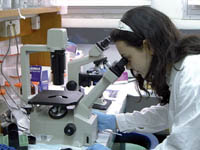 Fig. 2: Many science centers focus on engaging students in actual research work. In some cases this research is conducted in educational labs, whereas in other cases students join scientists in the research lab.
Fig. 2: Many science centers focus on engaging students in actual research work. In some cases this research is conducted in educational labs, whereas in other cases students join scientists in the research lab.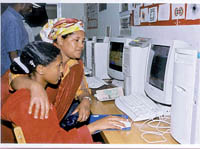 Fig. 3: Proud Ethiopian immigrant mother follows her daughter’s computer work during a special "Parents Day" of an extra-curricular science education program for Ethiopian immigrant students. The program helps motivated and advanced students of Ethiopian origin to get the support other students may have at home. Certain sections of society may need special, custom-made programs to meet their specific needs.
Fig. 3: Proud Ethiopian immigrant mother follows her daughter’s computer work during a special "Parents Day" of an extra-curricular science education program for Ethiopian immigrant students. The program helps motivated and advanced students of Ethiopian origin to get the support other students may have at home. Certain sections of society may need special, custom-made programs to meet their specific needs.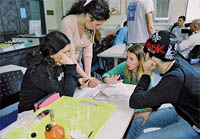 Fig. 4: Four team members in action during the Chemistry Tour-nament. Typically, team contests draw more girls than individual competitions, and among the chemists, they are the majority.
Fig. 4: Four team members in action during the Chemistry Tour-nament. Typically, team contests draw more girls than individual competitions, and among the chemists, they are the majority.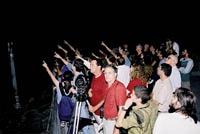 Fig. 5: A moment of excitement among the adult and youth participants of the astronomy club.
Fig. 5: A moment of excitement among the adult and youth participants of the astronomy club.